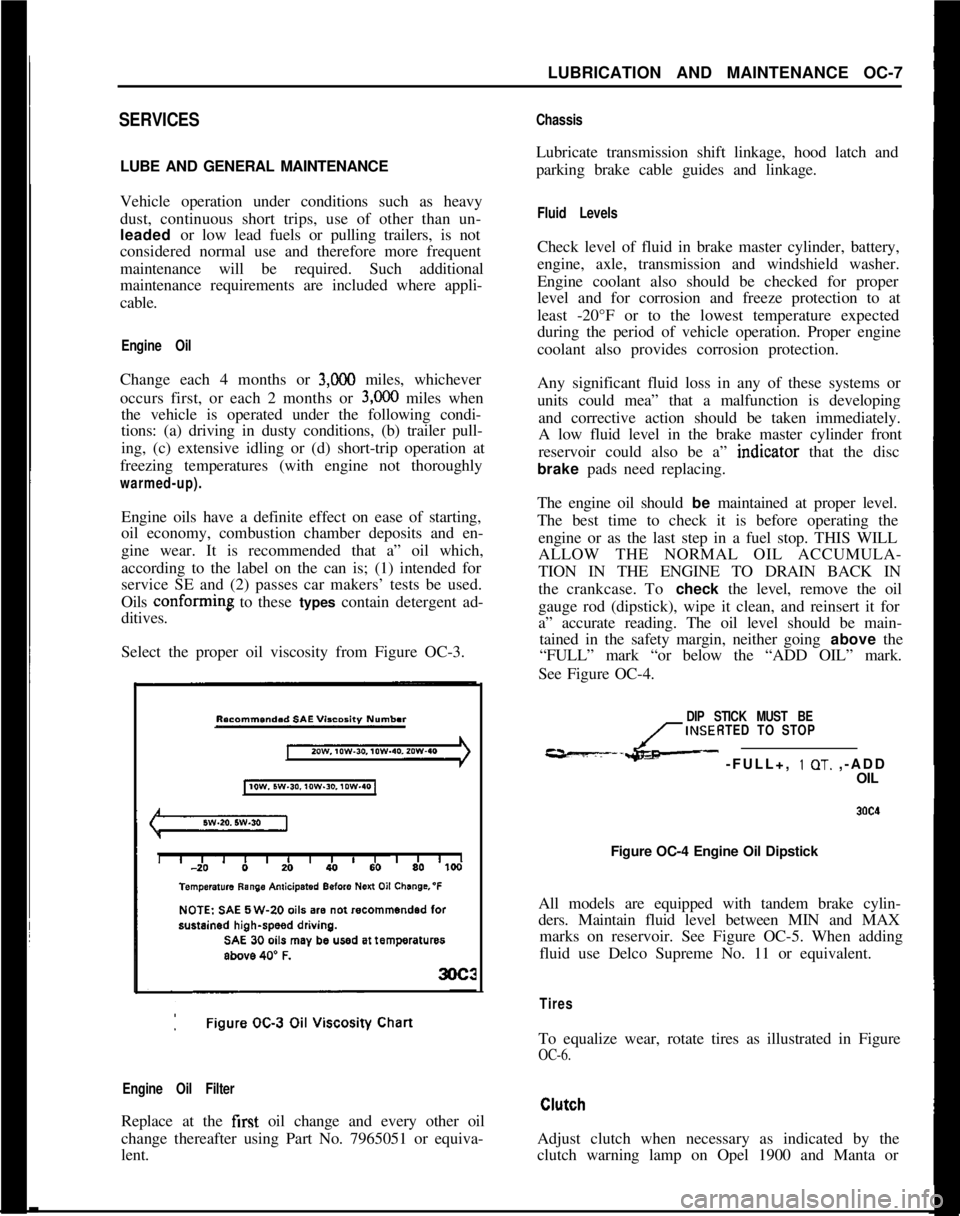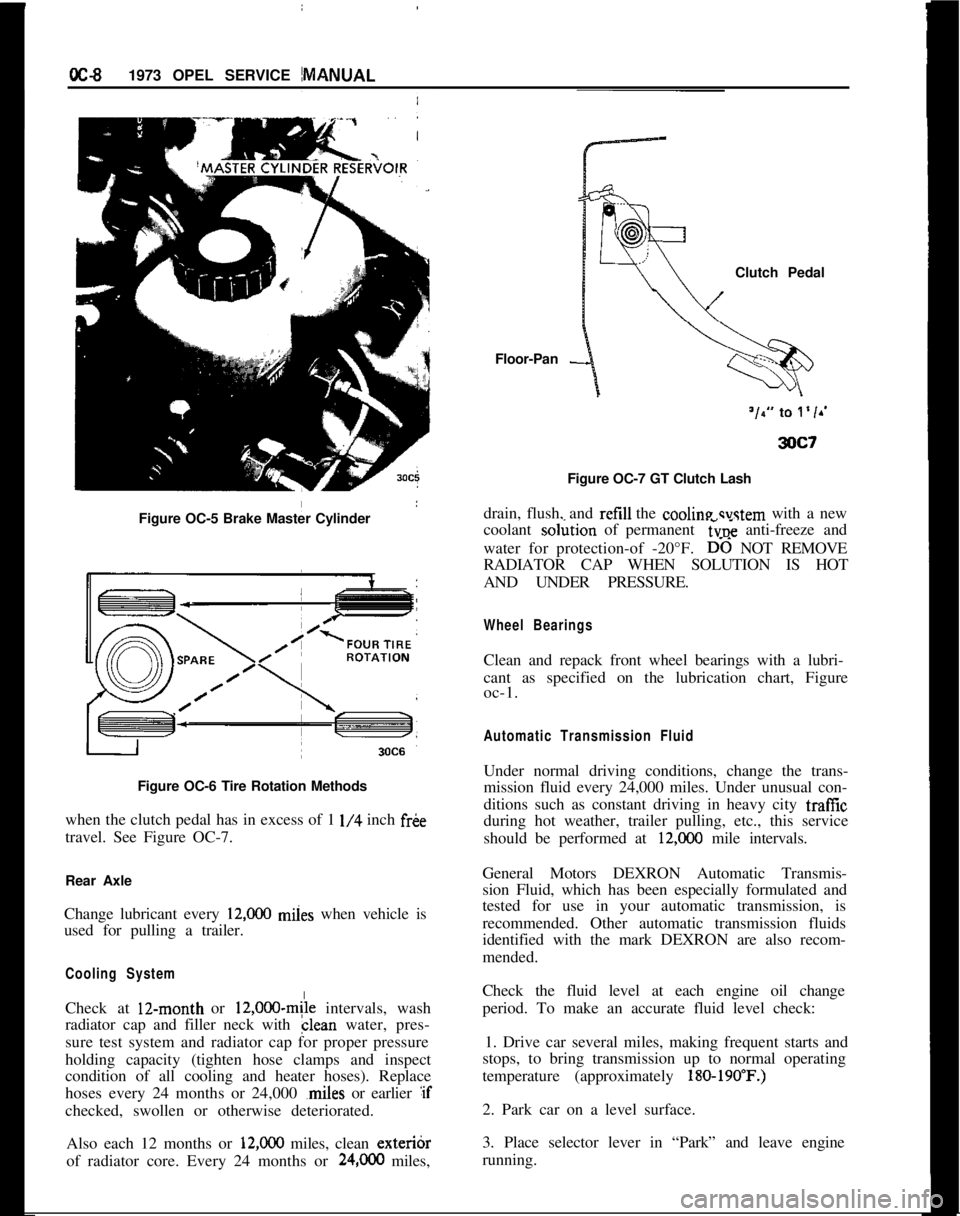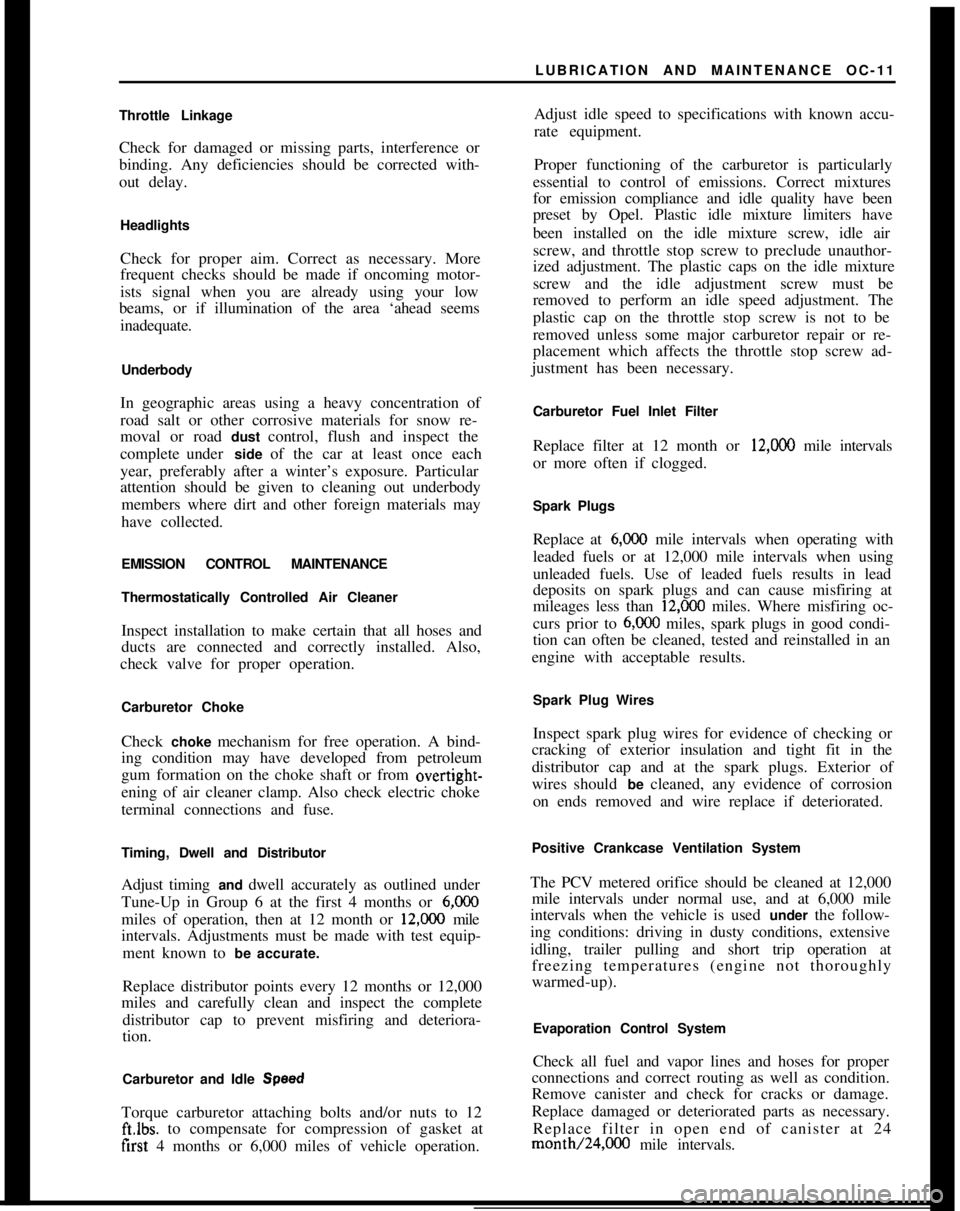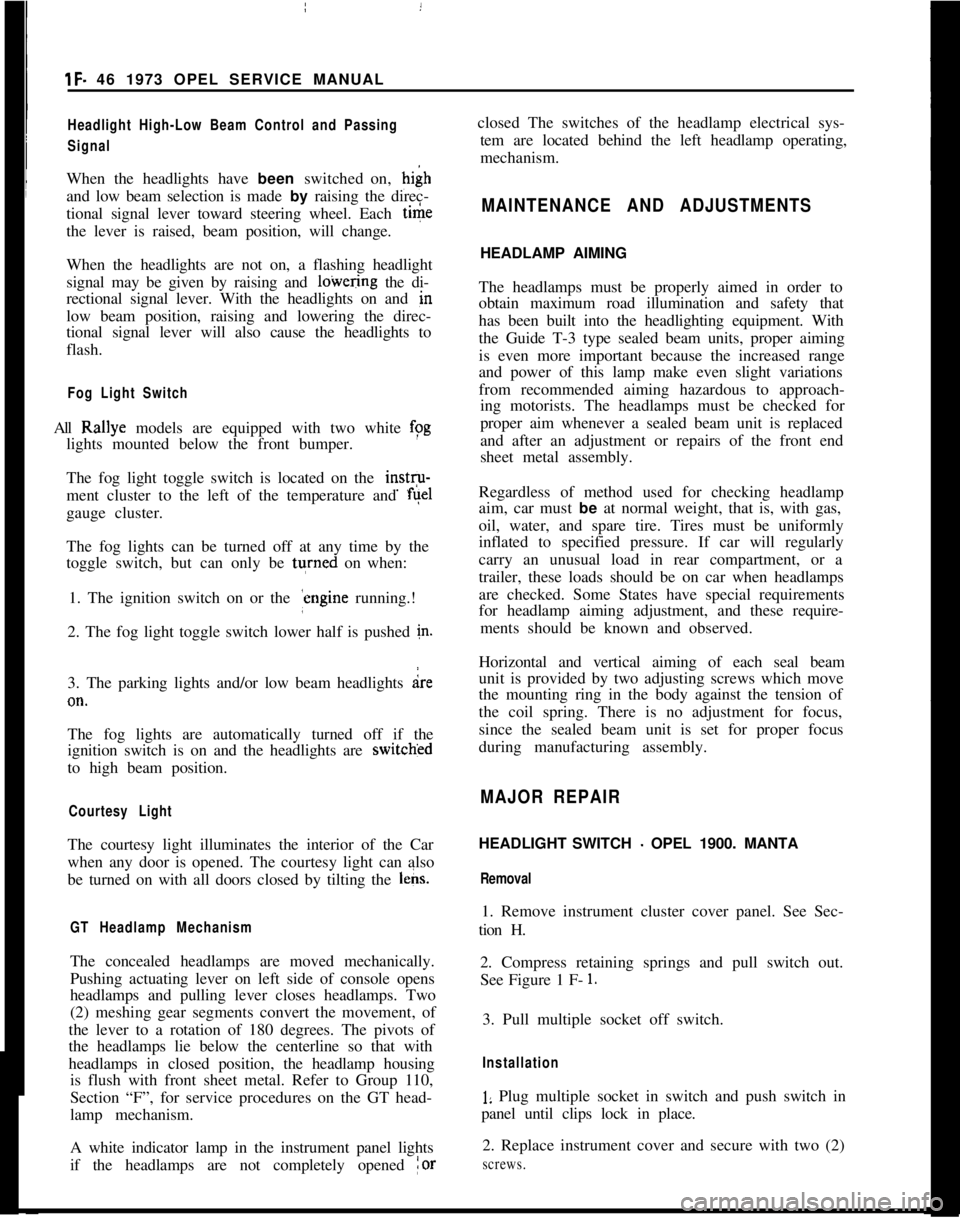trailer OPEL GT-R 1973 Service Manual
[x] Cancel search | Manufacturer: OPEL, Model Year: 1973, Model line: GT-R, Model: OPEL GT-R 1973Pages: 625, PDF Size: 17.22 MB
Page 16 of 625

LUBRICATION AND MAINTENANCE OC-7SERVICESLUBE AND GENERAL MAINTENANCE
Vehicle operation under conditions such as heavy
dust, continuous short trips, use of other than un-
leaded or low lead fuels or pulling trailers, is not
considered normal use and therefore more frequent
maintenance will be required. Such additional
maintenance requirements are included where appli-
cable.
Engine OilChange each 4 months or
3,COO miles, whichever
occurs first, or each 2 months or
3,ooO miles when
the vehicle is operated under the following condi-
tions: (a) driving in dusty conditions, (b) trailer pull-
ing, (c) extensive idling or (d) short-trip operation at
freezing temperatures (with engine not thoroughly
warmed-up).Engine oils have a definite effect on ease of starting,
oil economy, combustion chamber deposits and en-
gine wear. It is recommended that a” oil which,
according to the label on the can is; (1) intended for
service SE and (2) passes car makers’ tests be used.
Oils confotming to these types contain detergent ad-
ditives. -
Select the proper oil viscosity from Figure OC-3.
Engine Oil FilterReplace at the first oil change and every other oil
change thereafter using Part No. 7965051 or equiva-
lent.
ChassisLubricate transmission shift linkage, hood latch and
parking brake cable guides and linkage.
Fluid LevelsCheck level of fluid in brake master cylinder, battery,
engine, axle, transmission and windshield washer.
Engine coolant also should be checked for proper
level and for corrosion and freeze protection to at
least -20°F or to the lowest temperature expected
during the period of vehicle operation. Proper engine
coolant also provides corrosion protection.
Any significant fluid loss in any of these systems or
units could mea” that a malfunction is developing
and corrective action should be taken immediately.
A low fluid level in the brake master cylinder front
reservoir could also be a” indtcator that the disc
brake pads need replacing.
The engine oil should be maintained at proper level.
The best time to check it is before operating the
engine or as the last step in a fuel stop. THIS WILL
ALLOW THE NORMAL OIL ACCUMULA-
TION IN THE ENGINE TO DRAIN BACK IN
the crankcase. To check the level, remove the oil
gauge rod (dipstick), wipe it clean, and reinsert it for
a” accurate reading. The oil level should be main-
tained in the safety margin, neither going above the
“FULL” mark “or below the “ADD OIL” mark.
See Figure OC-4.
DIP STICK MUST BE
INSERTED TO STOP
---L- -FULL+, 1 OT. ,-ADD
OIL
Figure OC-4 Engine Oil Dipstick
All models are equipped with tandem brake cylin-
ders. Maintain fluid level between MIN and MAX
marks on reservoir. See Figure OC-5. When adding
fluid use Delco Supreme No. 11 or equivalent.
TiresTo equalize wear, rotate tires as illustrated in Figure
OC-6.Adjust clutch when necessary as indicated by the
clutch warning lamp on Opel 1900 and Manta or
Page 17 of 625

IoC-91973 OPEL SERVICE MANUAL
Figure OC-5 Brake Master Cylinder
I
Figure OC-6 Tire Rotation Methods
when the clutch pedal has in excess of 1
l/4 inch fr&
travel. See Figure OC-7.
Rear Axle
Change lubricant every
12,ooO miies when vehicle is
used for pulling a trailer.
Cooling SystemCheck at 12-month or
12,000~mile intervals, wash
radiator cap and filler neck with clean water, pres-
sure test system and radiator cap for proper pressure
holding capacity (tighten hose clamps and inspect
condition of all cooling and heater hoses). Replace
hoses every 24 months or 24,000 ,miles or earlier :if
checked, swollen or otherwise deteriorated.
Also each 12 months or
12,ooO miles, clean exteribr
of radiator core. Every 24 months or
24,OCO miles,Floor-Pan
-Clutch Pedal
Figure OC-7 GT Clutch Lash
drain, flush, and refill the cooline svstem with a new
coolant so&ion of permanent
6~; anti-freeze and
water for protection-of -20°F.
D-6 NOT REMOVE
RADIATOR CAP WHEN SOLUTION IS HOT
AND UNDER PRESSURE.
Wheel BearingsClean and repack front wheel bearings with a lubri-
cant as specified on the lubrication chart, Figure
oc-1.
Automatic Transmission FluidUnder normal driving conditions, change the trans-
mission fluid every 24,000 miles. Under unusual con-
ditions such as constant driving in heavy city traffic
during hot weather, trailer pulling, etc., this service
should be performed at
12,COO mile intervals.
General Motors DEXRON Automatic Transmis-
sion Fluid, which has been especially formulated and
tested for use in your automatic transmission, is
recommended. Other automatic transmission fluids
identified with the mark DEXRON are also recom-
mended.
Check the fluid level at each engine oil change
period. To make an accurate fluid level check:
1. Drive car several miles, making frequent starts and
stops, to bring transmission up to normal operating
temperature (approximately
180-190’F.)2. Park car on a level surface.
3. Place selector lever in “Park” and leave engine
running.
Page 20 of 625

LUBRICATION AND MAINTENANCE OC-11
Throttle Linkage
Check for damaged or missing parts, interference or
binding. Any deficiencies should be corrected with-
out delay.
Headlights
Check for proper aim. Correct as necessary. More
frequent checks should be made if oncoming motor-
ists signal when you are already using your low
beams, or if illumination of the area ‘ahead seems
inadequate.
Underbody
In geographic areas using a heavy concentration of
road salt or other corrosive materials for snow re-
moval or road dust control, flush and inspect the
complete under side of the car at least once each
year, preferably after a winter’s exposure. Particular
attention should be given to cleaning out underbody
members where dirt and other foreign materials may
have collected.
EMISSION CONTROL MAINTENANCE
Thermostatically Controlled Air Cleaner
Inspect installation to make certain that all hoses and
ducts are connected and correctly installed. Also,
check valve for proper operation.
Carburetor Choke
Check choke mechanism for free operation. A bind-
ing condition may have developed from petroleum
gum formation on the choke shaft or from overtight-
ening of air cleaner clamp. Also check electric choke
terminal connections and fuse.
Timing, Dwell and Distributor
Adjust timing and dwell accurately as outlined under
Tune-Up in Group 6 at the first 4 months or 6,ooOmiles of operation, then at 12 month or
12,OQO mile
intervals. Adjustments must be made with test equip-
ment known to be accurate.
Replace distributor points every 12 months or 12,000
miles and carefully clean and inspect the complete
distributor cap to prevent misfiring and deteriora-
tion.
Carburetor and Idle
SpeedTorque carburetor attaching bolts and/or nuts to 12
ft.lbs. to compensate for compression of gasket atiirst 4 months or 6,000 miles of vehicle operation.Adjust idle speed to specifications with known accu-
rate equipment.
Proper functioning of the carburetor is particularly
essential to control of emissions. Correct mixtures
for emission compliance and idle quality have been
preset by Opel. Plastic idle mixture limiters have
been installed on the idle mixture screw, idle air
screw, and throttle stop screw to preclude unauthor-
ized adjustment. The plastic caps on the idle mixture
screw and the idle adjustment screw must be
removed to perform an idle speed adjustment. The
plastic cap on the throttle stop screw is not to be
removed unless some major carburetor repair or re-
placement which affects the throttle stop screw ad-
justment has been necessary.
Carburetor Fuel Inlet Filter
Replace filter at 12 month or
12,OCO mile intervals
or more often if clogged.
Spark Plugs
Replace at
6,ooO mile intervals when operating with
leaded fuels or at 12,000 mile intervals when using
unleaded fuels. Use of leaded fuels results in lead
deposits on spark plugs and can cause misfiring at
mileages less than
12,OilO miles. Where misfiring oc-
curs prior to
6,ooO miles, spark plugs in good condi-
tion can often be cleaned, tested and reinstalled in an
engine with acceptable results.
Spark Plug Wires
Inspect spark plug wires for evidence of checking or
cracking of exterior insulation and tight fit in the
distributor cap and at the spark plugs. Exterior of
wires should be cleaned, any evidence of corrosion
on ends removed and wire replace if deteriorated.
Positive Crankcase Ventilation System
The PCV metered orifice should be cleaned at 12,000
mile intervals under normal use, and at 6,000 mile
intervals when the vehicle is used under the follow-
ing conditions: driving in dusty conditions, extensive
idling, trailer pulling and short trip operation at
freezing temperatures (engine not thoroughly
warmed-up).
Evaporation Control System
Check all fuel and vapor lines and hoses for proper
connections and correct routing as well as condition.
Remove canister and check for cracks or damage.
Replace damaged or deteriorated parts as necessary.
Replace filter in open end of canister at 24month/24,000 mile intervals.
Page 67 of 625

1F. 46 1973 OPEL SERVICE MANUAL
’
/
Headlight High-Low Beam Control and Passing:
SignalI
When the headlights have been switched on, high
and low beam selection is made by raising the direc-
tional signal lever toward steering wheel. Each
ti&the lever is raised, beam position, will change.
When the headlights are not on, a flashing headlight
signal may be given by raising and lotiering the di-
rectional signal lever. With the headlights on and
inlow beam position, raising and lowering the direc-
tional signal lever will also cause the headlights to
flash.
Fog Light SwitchAll Rallye models are equipped with two white f?g
lights mounted below the front bumper.
The fog light toggle switch is located on the
insty-ment cluster to the left of the temperature and
fuelgauge cluster.
/
The fog lights can be turned off at any time by the
toggle switch, but can only be tyrned on when: :
1. The ignition switch on or the
?gine running.!
2. The fog light toggle switch lower half is pushed
in.3. The parking lights and/or low beam headlights
are
OKThe fog lights are automatically turned off if the
ignition switch is on and the headlights are switched
to high beam position.
Courtesy LightThe courtesy light illuminates the interior of the Car
when any door is opened. The courtesy light can also
be turned on with all doors closed by tilting the l&s.
GT Headlamp MechanismThe concealed headlamps are moved mechanically.
Pushing actuating lever on left side of console opens
headlamps and pulling lever closes headlamps. Two
(2) meshing gear segments convert the movement, of
the lever to a rotation of 180 degrees. The pivots of
the headlamps lie below the centerline so that with
headlamps in closed position, the headlamp housing
is flush with front sheet metal. Refer to Group 110,
Section “F”, for service procedures on the GT head-
lamp mechanism.
A white indicator lamp in the instrument panel lights
if the headlamps are not completely opened lorclosed The switches of the headlamp electrical sys-
tem are located behind the left headlamp operating,
mechanism.
MAINTENANCE AND ADJUSTMENTSHEADLAMP AIMING
The headlamps must be properly aimed in order to
obtain maximum road illumination and safety that
has been built into the headlighting equipment. With
the Guide T-3 type sealed beam units, proper aiming
is even more important because the increased range
and power of this lamp make even slight variations
from recommended aiming hazardous to approach-
ing motorists. The headlamps must be checked for
proper aim whenever a sealed beam unit is replaced
and after an adjustment or repairs of the front end
sheet metal assembly.
Regardless of method used for checking headlamp
aim, car must be at normal weight, that is, with gas,
oil, water, and spare tire. Tires must be uniformly
inflated to specified pressure. If car will regularly
carry an unusual load in rear compartment, or a
trailer, these loads should be on car when headlamps
are checked. Some States have special requirements
for headlamp aiming adjustment, and these require-
ments should be known and observed.
Horizontal and vertical aiming of each seal beam
unit is provided by two adjusting screws which move
the mounting ring in the body against the tension of
the coil spring. There is no adjustment for focus,
since the sealed beam unit is set for proper focus
during manufacturing assembly.
MAJOR REPAIRHEADLIGHT SWITCH
- OPEL 1900. MANTA
Removal1. Remove instrument cluster cover panel. See Sec-
tion H.
2. Compress retaining springs and pull switch out.
See Figure 1 F-
1.3. Pull multiple socket off switch.
Installation
1: Plug multiple socket in switch and push switch in
panel until clips lock in place.
2. Replace instrument cover and secure with two (2)
screws.
Page 161 of 625

2H-381973 OPEL SERVICE MANUAL
BUMPERS
CONTENTS
Subject
DESCRIPTION AND OPERATION: Protective Moldings
. . . . . . . . . . . . . . . . . . . . . . . . . . . . . . . . . . . . \
. . . . *. . . . . . . . . . . . . . . . .
DIAGNOSIS: (Not Applicable)
MAINTENANCE AND ADJUSTMENTS: (Not
Applicable) MAJOR REPAIR: Removal and Installation
1900
- Manta. . . . . . . . . . . . . . . . . . . . . . . . . . . . . . . . . . . . \
. . . . . . . . . . . . . . . . . . . . . . . . . . . . . .
GT. . . . . . . . . . . . . . . . . . . . . . . . . . . * . . . . . . . . . . . . . . . . . . . . . . . . . . . . . . . . . . . .\
. . . . . . . . . . . . . . . . . . . . . . . .
Trailer Hitch Installation, . , . . . . . . . . . . . , . . . . . . . . . . . . . . . . . . . . . \
. . . . . . . . . . . . . .
SPECIFICATIONS: (Not Applicable) Page No.
2H-38
2H-38
2H-39
2H-41
DESCRIPTION ‘AND OPERATION
PROTECTIVE MOLDINGS
All 1973 Opel bumpers are equipped with rubber
protective moldings as standard equipment. The
moldings are easily removed by removing the attach-
ing nuts located on the inboard side of the bumper.
MAJOR REPAIR
REMOVAL AND INSTALLATION OF FRONT
BUMPER AND BUMPER GUARDS
(OPEL 1900 -
MANTA)
Removal
1. Remove bumper attaching screws on inside
- left
and right
- and from left and right brackets. See
Figure
2H-2.
2. From the front, unscrew bumper guard attaching
screws. See Figure‘
2H-2.
Remove bumper and bumper guards.
Installation
1. Attach bumper guards to bumper.
Figure ZH-2 Bumper Attaching Screws
2. From the front, secure bumper guards with attach-
ing screws. See Figure
2H-2.
3. Install attaching bolts on left and right brackets,
and on left and right inside. See Figure
2H-2.
REMOVAL AND INSTALLATION OF FRONT
BUMPER BRACKETS (OPEL 1900
- MANTA)
The front bumper brackets are attached with three
screws. Removal of the three screws will allow re- moval and installation of the front bumper brackets.
See Figure
2H-3.
REMOVAL AND INSTALLATION OF REAR
BUMPER AND GUARDS (OPEL 1900
- MANTA)
1. Remove license plate lamp.
2. Remove bumper attaching screws and bumper
brackets. See Figure
2H-4.
Page 164 of 625

3116” SPACERSAFET‘;. CHAIN PLATE
(Dl -l/Z x 3INSTALLATION INSTRUCTIONS
1969
- 73 OPEL GT TRAILER HITCH LESS BALL
GROUP 7.068
STEP 1.REMOVE ONE RIGHT HAND AND ONE LEFT HAND
TAIL LAMP ASSEMBLY,
STEP 2.PLACE TIE BAR (C) UNDER THE REAR BODY
PANEL BY PULLING DOWN ON THE EXHAUST PIPES AND
SLIDING THE TIE BAR OVER THE PIPES AND INTO
POSITION. PLACE DRAW BAR (Al UNDER TIE BAR ICI
AND FASTEN WITH A
112 x 2” HEX BOLT WITH LOCK
WASHER AND NUT UNDER DRAW BAR (A). PLACE TIE
BAR (8) UNDER DRAW BAR IAl AND SAFETY CHAIN PLATE(DI UNDER TIE BAR
(B) AND FASTEN WITH A 112 ‘x 2-114”HEX BOLT WITH FLAT WASHER, LOCK WASHER AND NUT
BELOW SAFETY CHAIN PLATE IDI.
STEP 3. HOLD HITCH IN POSITION WITH TIE BAR (Cl
UNDE~R THE REAR BODY PANEL AND TIE BAR (RI
BETWEEN THE BUMPER GUARDS. USING THE HOLES IN
THE ENDS OF TIE BAR (Cl AS A GUIDE, LOCATE, MARK
AND DRILL TWO
112” HOLES IN THE VERTICAL PORTION
OF THE REAR BODY PANEL. PLACE THE 3/16” SPACERS
ON THE
112 x l-l/2 HEX BOLTS AND BY REACHING
THROUGH THE TAIL LAMP OPENINGS, INSERT THE BOLTS
THROUGH THE BODY PANEL AND TIE BAR (Cl AND
FASTEN WITH LOCK WASHER AND NUT.
STEP 4. ALIGN TIE BAR (8) BETWEEN THE
BUMP,ER GUARDS
AND LOCATE, MARK AND DRILL A 112~ HOLE THROUGH
BOTH SIDES OF THE BUMPER GUARD USING THE HOLES
IN TIE BAR IBI AS A GUIDE. MAINTAIN
112 lNCH.MlNlMUM
CLEARANCE BETWEEN TOP OF DRAW BAR.(A) AND
BOTTOM OF BACK-UP LIGHT. FASTEN TIE BAR
(Bl ,TO’THE BUMPER GUARDS WITH 112 x 3” BOLTS WITH TWO.112”
SPACERS AND ONE 318” SPACER INSIDE EACH BUMPER
GUARD. REPLACE TAIL LAMP ASSEMBLES.
TIGHTEN ALL
112” NUTS.TO A MAXIMUP,.TOROUE OF
60 FOOT LBS.
INSTALL BALL US1NG.A MAXIMUM.TOR~DUE OF
150 FOOT LBS.
MAXIMUM GROSS WEIGHT 1000 LBS.
MAXIMUM TONGUE WEIGHT 100 LBS.
MOST STATES PROHIBIT OBSTRUCTION OF LICENSE.
PLATES. BALL SHOULD BE REMOVED WHEN NOT IN
USE IF IT OBSTRUCTS A CLEAR VIEW.2H.8
Figure 2H-8 GT Trailer Hitch Installation
Page 165 of 625

FLVTRlJNK PLAT
DRAW BAR16x1-1/2 -DRAW‘ BAR EXTENSION-%GSAFETY CHAIN PLATE6INSTALLATION INSTRUCTIONS
1971
- 72 - 73 OPEL 1900 SERIES S/W
GROUP NO. 7.068
REMOVE LICENSE PLATE
STEP 1. ASSEMBLE HITCH AS ILLUSTRATED. HOLD
HITCH IS POSITION WITH FLOOR PLATE RESTING
AGAINST THE CROSS FRAME IN FRONT OF GAS TANK.
CENTER DRAW BAR SUPPORT ON THE REAR BODY
PANEL, RAISE UNTIL LEVEL.
STEP 2.MARK AND DRILL TWO
7116” HOLES IN REAR
BODY PANEL AND ATTACH AS SHOWN.
STEP 3.DRILL TWO
112” HOLES IN CROSS FRAME IN
FRONT OF THE GAS TANK AND CONTINUE DRILLING UP
THROUGH THE INNER FLOOR. NOTE: HOLD DRILL
VERTICAL WHILE DRILLING THROUGH THE INNER FLOOR.
ENLARGE BOTTOM HOLE SLIGHTLY TO ACCEPT SPACER.
STEP 4. ATTACH TRUNK PLATE AS ILLUSTRATED. PLACE
THE FLOOR PLATES ON THE 2
l/2” CARRIAGE BOLTS
AND INSERTS THROUGH THE OPENINGS
iN THE BACK OF
THE TRUNK WELL.INSERT SPACERS AS SHOWN AND
COMPLETE INSTALLATION.
REPLACE LICENSE PLATE.
TIGHTEN ALL
112” NUTS TO A MAXIMUM TORQUE OF
60 FOOT LBS. AND 7/16” NUTS TO A MAXIMUM OF
45 FOOT LBS.
INSTALL BALL USING A MAXIMUM TORQUE OF 150
FOOT LBS.
MAXIMUM GROSS WEIGHT 100 LBS
MAXIMUM TONGUE WEIGHT 100 LBS.
MOST STATES PROHIBIT OBSTRUCTION OF LICENSE
PLATES, BALL SHOULD BE REMOVED WHEN NOT IN
USE IF IT OBSTRUCTS A CLEAR VIEW.
ZH-9Figure
ZH-9 Opel 1900 Wagon Trailer Hitch Installation
Page 166 of 625

AFETY CHAINPLATEINSTALLATION INSTRUCTIONS
1971-72-73 OPEL 50 SER.. LESS S/WAGON CAR TRAILER HITCH
GROUP NO. 7.068
STEP 1.REMOVE LICENSE PLATE, ASSEMBLE V-BAR AND
SAFETY CHAIN PLATE TO DRAW BAR AS ILLUSTRATED.
HOLD HITCH IN POSITION WITH THE DRAW EAR LEVEL
AND THE V-BAR RESTING ON THE REAR BODY PANEL.
MARK AND DRILL TWO l/2” HOLES THROUGH THE BODY
AND ATTACH THE V-BAR AS ILLUSTRATED.
STEP ‘2. ALIGN THE ORAW BAR IN THE CENTER OF THE
TRUCK FLOOR AND DRILL A
l/2” HOLE THROUGH THE
FLOOR USING THE HOLE IN THE DRAW BAR AS A GUIDE.
ATTACH THE FLOOR PLATE AND FLOOR STRAP AS
ILLUSTRATED. DRILL THE TWO REMAINING HOLES IN
THE FLOOR AND COMPLETE INSTALLATION AS ILLUSTRATED
REPLACE LICENSE PLATE.
TIGHTEN ALL
112” NUTS TO A TORQUE OF 60 FOOT LBS.II\STALL BALL USING A TORQUE OF 150 FOOT LBS.
MAXIMUM GROSS WEIGHT 1000 LBS.
MAXIMUM TONGUE WEIGHT 100 LBS.
MOST STATES PROHIBIT OBSTRUCTION OF LICENSE PLATES.
BALL SHOULD BE REMOVED WHEN NOT IN USE IF IT
OBSTRUCTS A CLEAR VIEW.
ZH-10Figure ZH-10 Opel 1900
- Manta - Less Wagon -Trailer Hitch lnsfallafion
Page 230 of 625

WHEELS AND TIRES36-63would require inflation pressures above the maximum allowable, speed must be
limited to 75 miles per hour.
3.Cool tire inflation pressure: After vehicle has been inoperative for 3 hours
or more, or driven less than one mile. Hot tire inflation pressure: After vehicle
has been driven
10 miles or more at 60-70 MPH.
4.Vehicles with luggage racks do not have a vehicle load limit greater than
specified.
5. When towing trailers, the allowable passenger and cargo load must be
reduced by an amount equal to the trailer tongue load on the trailer hitch.
Torque SpecificationWheelNuts
. . . . . . . . . . . . . . . . . . . . . . . . . . . . . . . . . . . . . . . . . . . . . . . . . . . . . . . . . . . . . . . . . . . . . . . . . . . . . . . . . .65lb.ft.
IFigure 3G-8 Wheel and Tire - Exploded View